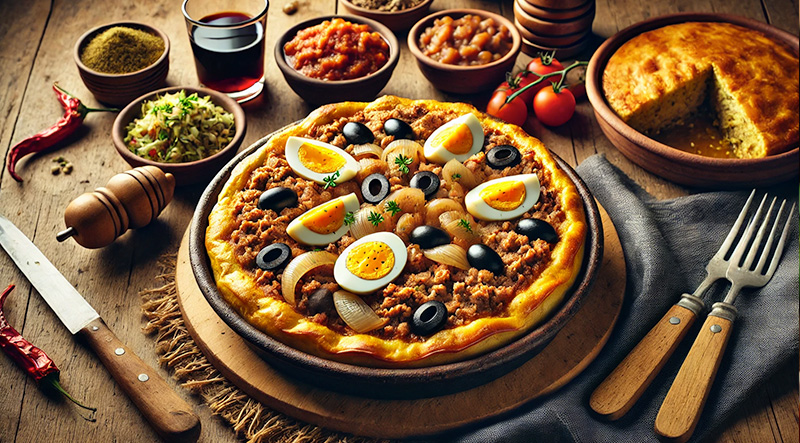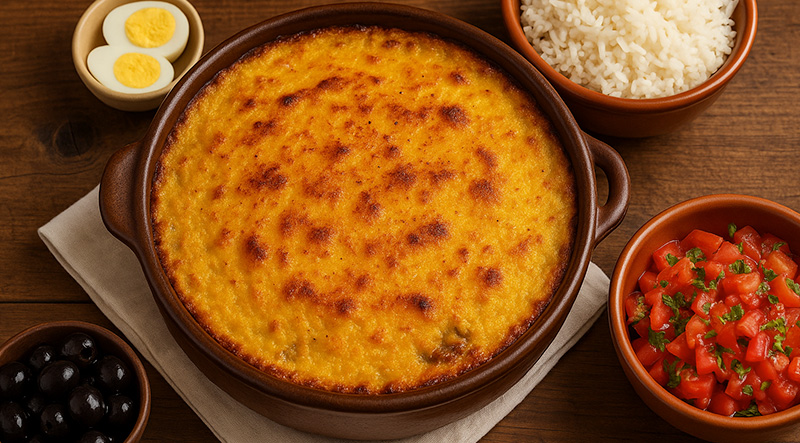If Chile had a flavor, it would be the warm, comforting embrace of Pastel de Choclo. Served bubbling hot from the oven, this quintessential dish is the soul of Chilean home cooking. It's a culinary treasure hunt in a bowl: a sweet, golden blanket of corn pudding covers a savory filling of spiced pino and surprises of chicken and olive. More than just a meal, it's a taste of summer sunshine, family gatherings, and pure, unadulterated comfort. Read More...
The History of Pastel de Choclo: Chile’s Corn-Powered Comfort Classic:
Pastel de Choclo is more than just a delicious dish—it’s a reflection of Chile’s rich cultural history, blending indigenous traditions with colonial influences to create a unique national treasure. At its heart, this beloved corn casserole captures the essence of Chilean home cooking, comfort, and identity.
Roots in the Andes:
The story of Pastel de Choclo begins with choclo, the native Andean corn that has been cultivated for thousands of years across South America. Unlike the sweet corn common in North America, choclo has larger, starchier kernels, giving it a hearty texture that works perfectly for mashing or puréeing. For centuries, indigenous peoples used choclo in a variety of dishes, often mixing it with meats and vegetables in ways that prefigure today’s casserole-style meals.
Spanish Influence and Colonial Fusion:
When Spanish colonists arrived in Chile in the 16th century, they brought with them new ingredients and cooking techniques—such as the idea of meat-based fillings and baking casseroles. The Spanish also introduced domesticated animals like cows and chickens, which became essential to Chilean diets. The fusion of these culinary traditions—indigenous choclo and Spanish-style stews and meats—laid the foundation for Pastel de Choclo.
One key element of Pastel de Choclo is pino, a savory mix of ground beef, onions, and spices. This meat mixture is also used in Chilean empanadas and likely has roots in Spanish picadillo, a similar seasoned ground meat preparation. When combined with other traditional components like hard-boiled eggs, black olives, and raisins, the result is a flavor profile that is simultaneously sweet, salty, and deeply satisfying.
From Rural Tradition to National Icon
Historically, Pastel de Choclo was a peasant or rural dish, often prepared in clay pots and cooked in wood-fired ovens. It was especially common in central Chile’s countryside, where corn and chickens were easily accessible and families often grew their own ingredients.
Over time, this humble dish became a national symbol, found in restaurants, homes, and holiday feasts throughout the country. Today, it’s a point of pride on Chilean tables, often served during Fiestas Patrias (Chile’s independence celebrations) and other special gatherings.
A Dish That Tells a Story:
What makes Pastel de Choclo so iconic is its ability to bridge past and present. Each bite carries echoes of Chile’s indigenous heritage, colonial history, and agricultural traditions. It celebrates the land, the people, and the resilience of a cuisine shaped by diverse influences and local pride.
Whether enjoyed in a rustic village kitchen or a Santiago restaurant, Pastel de Choclo is more than just food—it’s a delicious chapter in Chile’s culinary story, baked with history, layered with culture, and always served with heart.
Prepare the Corn Topping:
Make the Pino (Meat Filling):

Assemble the Pastel:
Bake to Perfection:

Optional Garnishes:
Enjoy your warm, sweet-and-savory slice of Chilean tradition! Let me know if you’d like a vegetarian version or calorie count.
The total preparation and cooking time for Pastel de Choclo is approximately 1 hour and 15 minutes. This includes about 30 minutes of prep, such as chopping onions, blending the corn mixture, cooking the meat filling, and assembling the layers. The dish then requires 35 to 45 minutes of baking in the oven until the corn topping is golden and caramelized. If you opt to use fresh corn or prepare chicken from scratch, allow an additional 10–15 minutes.
A single serving of Pastel de Choclo, based on the recipe provided and assuming the dish serves six people, contains approximately 450 to 550 calories. This includes the natural sugars and starches from the corn topping, the fat and protein from the ground beef and optional chicken, and additional calories from the olives, eggs, and butter. The presence of raisins or additional toppings like cheese can slightly increase the count. Overall, it’s a hearty dish that offers a satisfying balance of carbohydrates, protein, and fats, making it a filling and flavorful meal.







